Physics Assignment: Thermodynamics, Heat Transfer, and Specific Heat
VerifiedAdded on 2020/04/15
|21
|3167
|52
Homework Assignment
AI Summary
This physics assignment delves into fundamental concepts of thermodynamics and heat transfer. It begins with an exploration of thermometers, temperature scales (Celsius and Kelvin), and the absolute zero concept. The assignment then differentiates between heat energy and temperature, followed by a discussion of the three modes of heat transfer: conduction, convection, and radiation, illustrated through examples like a hot water radiator and insulation methods. The document also examines electrical conductivity in metals and its relation to thermal conductivity. Furthermore, it covers specific heat capacity, latent heat of fusion, and latent heat of vaporization, including calculations related to heat transfer. Finally, the assignment describes an experiment to determine the specific heat capacity of a metal block using the electrical method, including apparatus, method, results, and a conclusion discussing independent and dependent variables, error analysis, and a scatter plot analysis.

PHYSICS
STUDENT ID:
[Pick the date]
STUDENT ID:
[Pick the date]
Paraphrase This Document
Need a fresh take? Get an instant paraphrase of this document with our AI Paraphraser
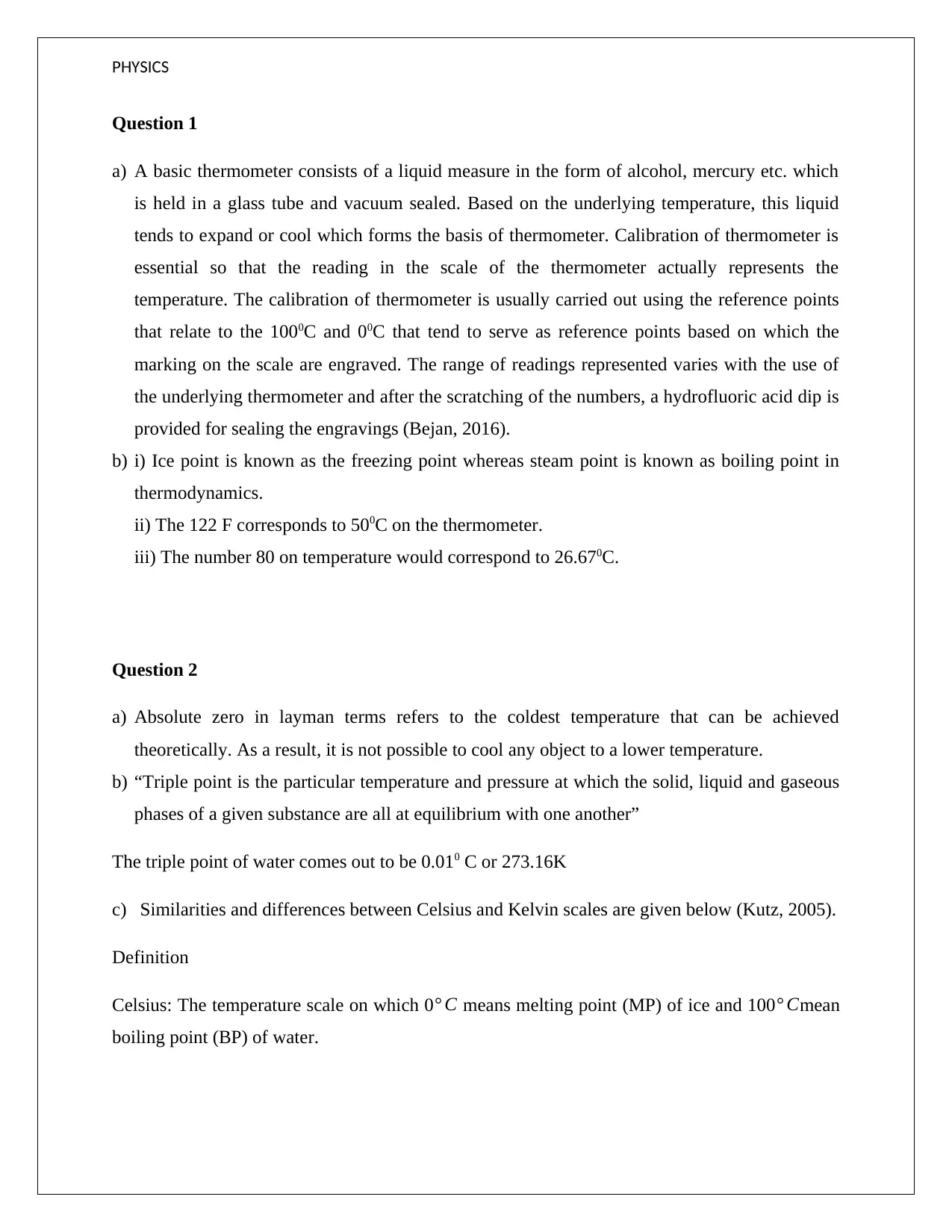
PHYSICS
Question 1
a) A basic thermometer consists of a liquid measure in the form of alcohol, mercury etc. which
is held in a glass tube and vacuum sealed. Based on the underlying temperature, this liquid
tends to expand or cool which forms the basis of thermometer. Calibration of thermometer is
essential so that the reading in the scale of the thermometer actually represents the
temperature. The calibration of thermometer is usually carried out using the reference points
that relate to the 1000C and 00C that tend to serve as reference points based on which the
marking on the scale are engraved. The range of readings represented varies with the use of
the underlying thermometer and after the scratching of the numbers, a hydrofluoric acid dip is
provided for sealing the engravings (Bejan, 2016).
b) i) Ice point is known as the freezing point whereas steam point is known as boiling point in
thermodynamics.
ii) The 122 F corresponds to 500C on the thermometer.
iii) The number 80 on temperature would correspond to 26.670C.
Question 2
a) Absolute zero in layman terms refers to the coldest temperature that can be achieved
theoretically. As a result, it is not possible to cool any object to a lower temperature.
b) “Triple point is the particular temperature and pressure at which the solid, liquid and gaseous
phases of a given substance are all at equilibrium with one another”
The triple point of water comes out to be 0.010 C or 273.16K
c) Similarities and differences between Celsius and Kelvin scales are given below (Kutz, 2005).
Definition
Celsius: The temperature scale on which 0° C means melting point (MP) of ice and 100° Cmean
boiling point (BP) of water.
Question 1
a) A basic thermometer consists of a liquid measure in the form of alcohol, mercury etc. which
is held in a glass tube and vacuum sealed. Based on the underlying temperature, this liquid
tends to expand or cool which forms the basis of thermometer. Calibration of thermometer is
essential so that the reading in the scale of the thermometer actually represents the
temperature. The calibration of thermometer is usually carried out using the reference points
that relate to the 1000C and 00C that tend to serve as reference points based on which the
marking on the scale are engraved. The range of readings represented varies with the use of
the underlying thermometer and after the scratching of the numbers, a hydrofluoric acid dip is
provided for sealing the engravings (Bejan, 2016).
b) i) Ice point is known as the freezing point whereas steam point is known as boiling point in
thermodynamics.
ii) The 122 F corresponds to 500C on the thermometer.
iii) The number 80 on temperature would correspond to 26.670C.
Question 2
a) Absolute zero in layman terms refers to the coldest temperature that can be achieved
theoretically. As a result, it is not possible to cool any object to a lower temperature.
b) “Triple point is the particular temperature and pressure at which the solid, liquid and gaseous
phases of a given substance are all at equilibrium with one another”
The triple point of water comes out to be 0.010 C or 273.16K
c) Similarities and differences between Celsius and Kelvin scales are given below (Kutz, 2005).
Definition
Celsius: The temperature scale on which 0° C means melting point (MP) of ice and 100° Cmean
boiling point (BP) of water.
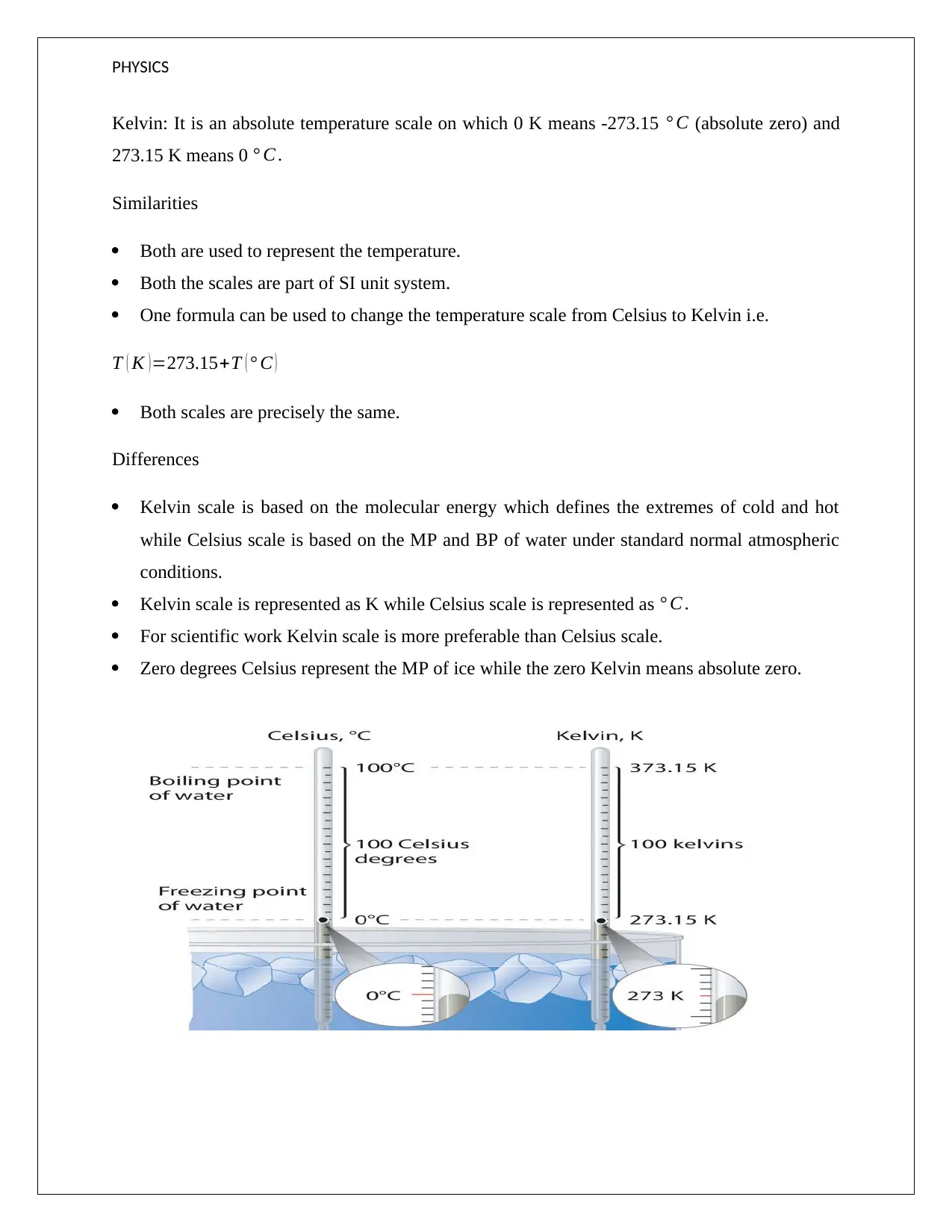
PHYSICS
Kelvin: It is an absolute temperature scale on which 0 K means -273.15 ° C (absolute zero) and
273.15 K means 0 ° C .
Similarities
Both are used to represent the temperature.
Both the scales are part of SI unit system.
One formula can be used to change the temperature scale from Celsius to Kelvin i.e.
T ( K )=273.15+T ( ° C )
Both scales are precisely the same.
Differences
Kelvin scale is based on the molecular energy which defines the extremes of cold and hot
while Celsius scale is based on the MP and BP of water under standard normal atmospheric
conditions.
Kelvin scale is represented as K while Celsius scale is represented as ° C .
For scientific work Kelvin scale is more preferable than Celsius scale.
Zero degrees Celsius represent the MP of ice while the zero Kelvin means absolute zero.
Kelvin: It is an absolute temperature scale on which 0 K means -273.15 ° C (absolute zero) and
273.15 K means 0 ° C .
Similarities
Both are used to represent the temperature.
Both the scales are part of SI unit system.
One formula can be used to change the temperature scale from Celsius to Kelvin i.e.
T ( K )=273.15+T ( ° C )
Both scales are precisely the same.
Differences
Kelvin scale is based on the molecular energy which defines the extremes of cold and hot
while Celsius scale is based on the MP and BP of water under standard normal atmospheric
conditions.
Kelvin scale is represented as K while Celsius scale is represented as ° C .
For scientific work Kelvin scale is more preferable than Celsius scale.
Zero degrees Celsius represent the MP of ice while the zero Kelvin means absolute zero.
⊘ This is a preview!⊘
Do you want full access?
Subscribe today to unlock all pages.

Trusted by 1+ million students worldwide
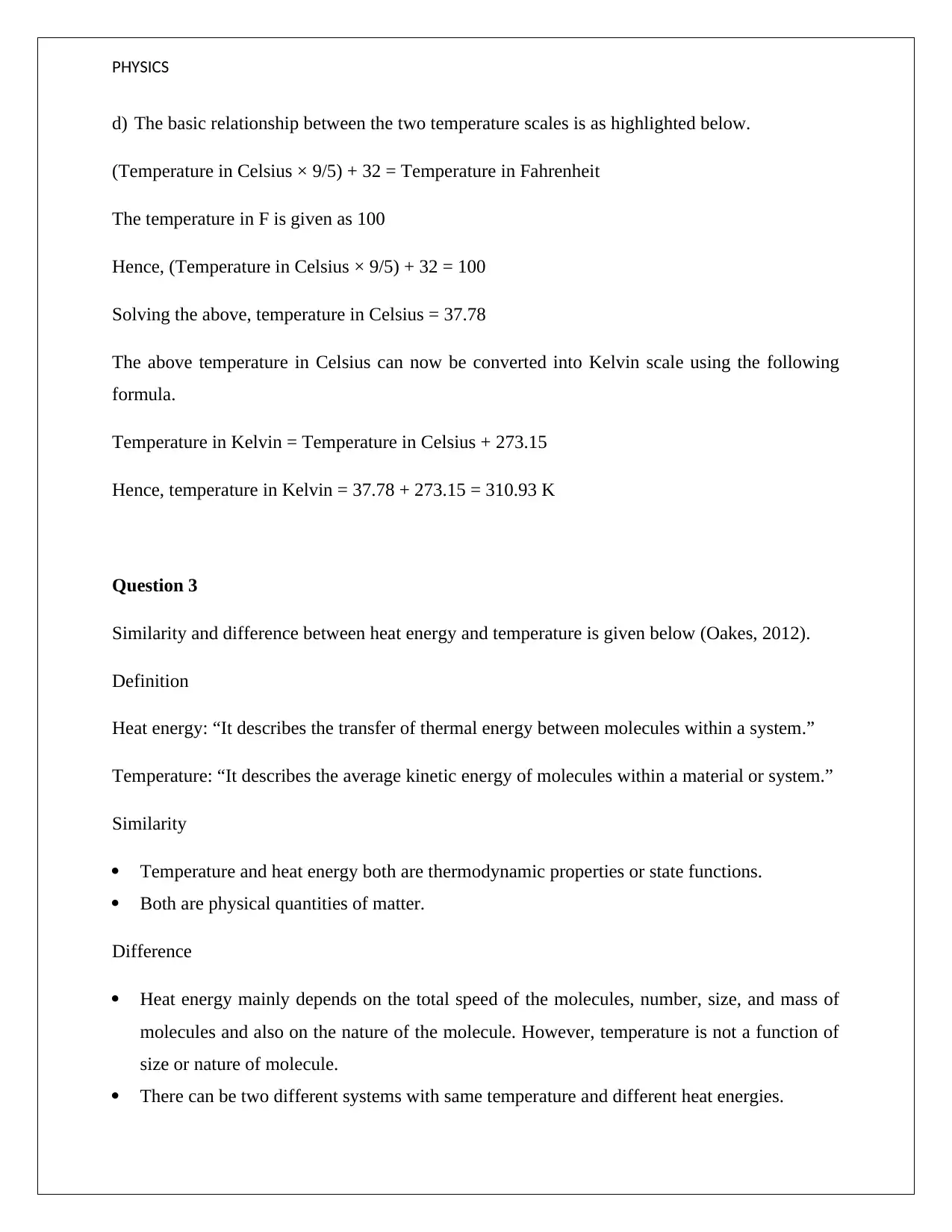
PHYSICS
d) The basic relationship between the two temperature scales is as highlighted below.
(Temperature in Celsius × 9/5) + 32 = Temperature in Fahrenheit
The temperature in F is given as 100
Hence, (Temperature in Celsius × 9/5) + 32 = 100
Solving the above, temperature in Celsius = 37.78
The above temperature in Celsius can now be converted into Kelvin scale using the following
formula.
Temperature in Kelvin = Temperature in Celsius + 273.15
Hence, temperature in Kelvin = 37.78 + 273.15 = 310.93 K
Question 3
Similarity and difference between heat energy and temperature is given below (Oakes, 2012).
Definition
Heat energy: “It describes the transfer of thermal energy between molecules within a system.”
Temperature: “It describes the average kinetic energy of molecules within a material or system.”
Similarity
Temperature and heat energy both are thermodynamic properties or state functions.
Both are physical quantities of matter.
Difference
Heat energy mainly depends on the total speed of the molecules, number, size, and mass of
molecules and also on the nature of the molecule. However, temperature is not a function of
size or nature of molecule.
There can be two different systems with same temperature and different heat energies.
d) The basic relationship between the two temperature scales is as highlighted below.
(Temperature in Celsius × 9/5) + 32 = Temperature in Fahrenheit
The temperature in F is given as 100
Hence, (Temperature in Celsius × 9/5) + 32 = 100
Solving the above, temperature in Celsius = 37.78
The above temperature in Celsius can now be converted into Kelvin scale using the following
formula.
Temperature in Kelvin = Temperature in Celsius + 273.15
Hence, temperature in Kelvin = 37.78 + 273.15 = 310.93 K
Question 3
Similarity and difference between heat energy and temperature is given below (Oakes, 2012).
Definition
Heat energy: “It describes the transfer of thermal energy between molecules within a system.”
Temperature: “It describes the average kinetic energy of molecules within a material or system.”
Similarity
Temperature and heat energy both are thermodynamic properties or state functions.
Both are physical quantities of matter.
Difference
Heat energy mainly depends on the total speed of the molecules, number, size, and mass of
molecules and also on the nature of the molecule. However, temperature is not a function of
size or nature of molecule.
There can be two different systems with same temperature and different heat energies.
Paraphrase This Document
Need a fresh take? Get an instant paraphrase of this document with our AI Paraphraser
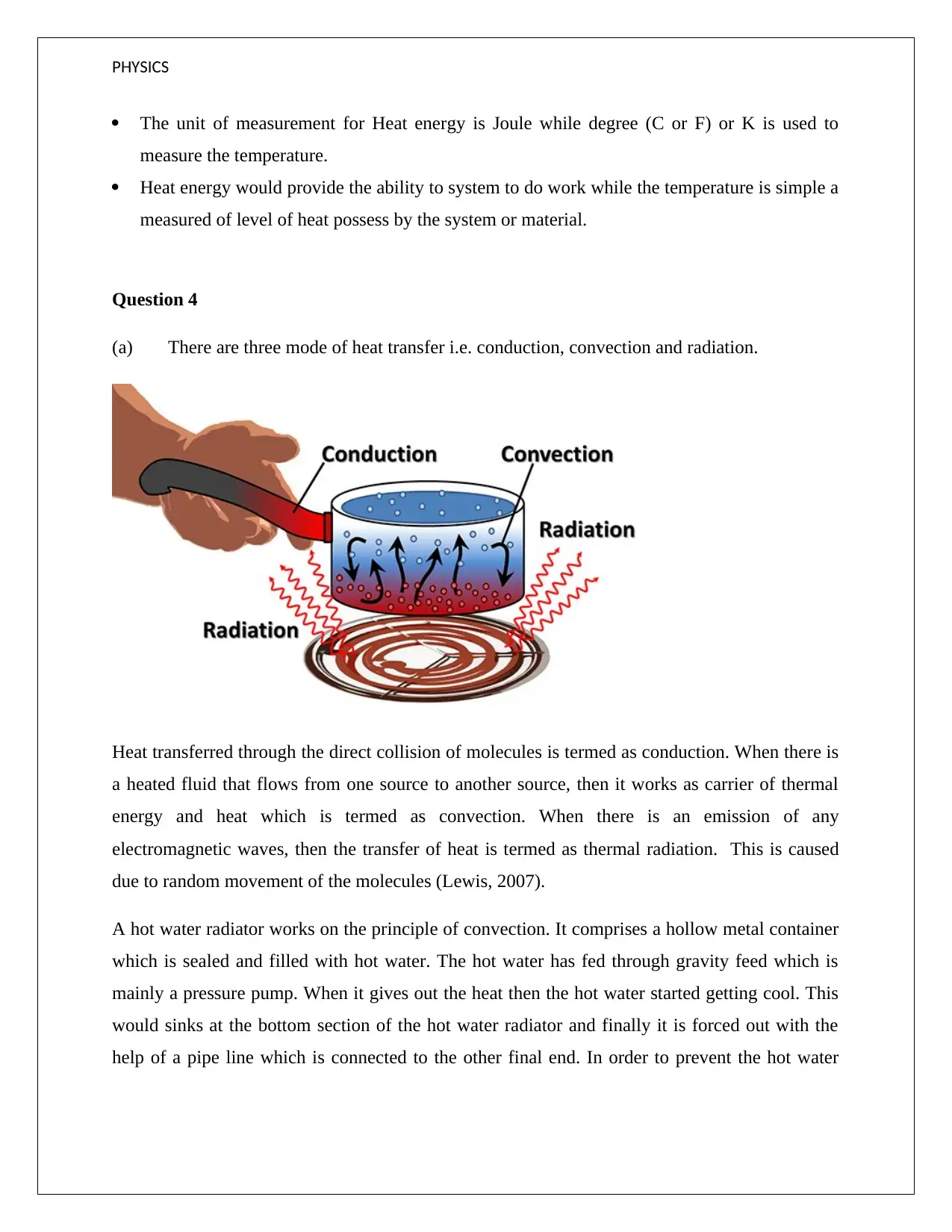
PHYSICS
The unit of measurement for Heat energy is Joule while degree (C or F) or K is used to
measure the temperature.
Heat energy would provide the ability to system to do work while the temperature is simple a
measured of level of heat possess by the system or material.
Question 4
(a) There are three mode of heat transfer i.e. conduction, convection and radiation.
Heat transferred through the direct collision of molecules is termed as conduction. When there is
a heated fluid that flows from one source to another source, then it works as carrier of thermal
energy and heat which is termed as convection. When there is an emission of any
electromagnetic waves, then the transfer of heat is termed as thermal radiation. This is caused
due to random movement of the molecules (Lewis, 2007).
A hot water radiator works on the principle of convection. It comprises a hollow metal container
which is sealed and filled with hot water. The hot water has fed through gravity feed which is
mainly a pressure pump. When it gives out the heat then the hot water started getting cool. This
would sinks at the bottom section of the hot water radiator and finally it is forced out with the
help of a pipe line which is connected to the other final end. In order to prevent the hot water
The unit of measurement for Heat energy is Joule while degree (C or F) or K is used to
measure the temperature.
Heat energy would provide the ability to system to do work while the temperature is simple a
measured of level of heat possess by the system or material.
Question 4
(a) There are three mode of heat transfer i.e. conduction, convection and radiation.
Heat transferred through the direct collision of molecules is termed as conduction. When there is
a heated fluid that flows from one source to another source, then it works as carrier of thermal
energy and heat which is termed as convection. When there is an emission of any
electromagnetic waves, then the transfer of heat is termed as thermal radiation. This is caused
due to random movement of the molecules (Lewis, 2007).
A hot water radiator works on the principle of convection. It comprises a hollow metal container
which is sealed and filled with hot water. The hot water has fed through gravity feed which is
mainly a pressure pump. When it gives out the heat then the hot water started getting cool. This
would sinks at the bottom section of the hot water radiator and finally it is forced out with the
help of a pipe line which is connected to the other final end. In order to prevent the hot water
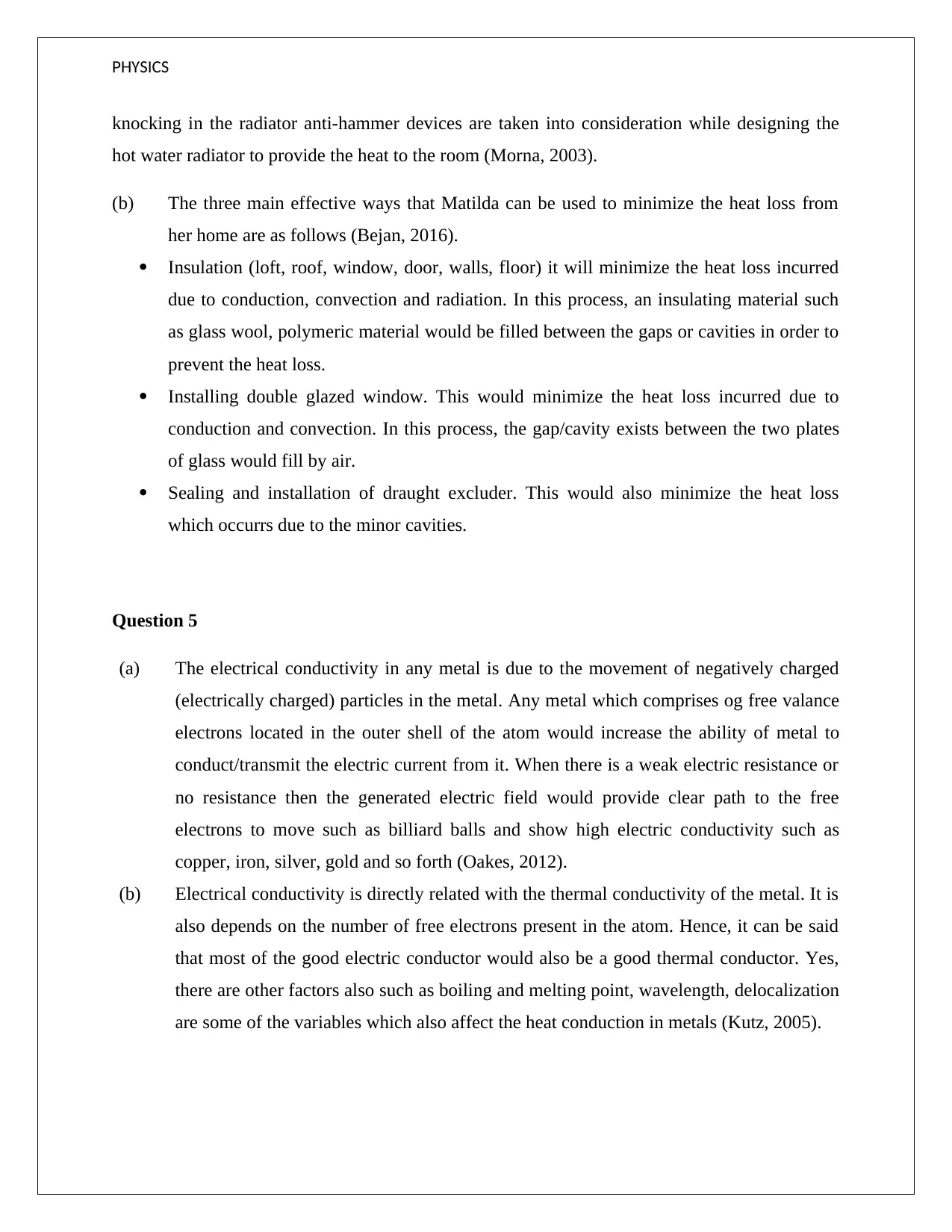
PHYSICS
knocking in the radiator anti-hammer devices are taken into consideration while designing the
hot water radiator to provide the heat to the room (Morna, 2003).
(b) The three main effective ways that Matilda can be used to minimize the heat loss from
her home are as follows (Bejan, 2016).
Insulation (loft, roof, window, door, walls, floor) it will minimize the heat loss incurred
due to conduction, convection and radiation. In this process, an insulating material such
as glass wool, polymeric material would be filled between the gaps or cavities in order to
prevent the heat loss.
Installing double glazed window. This would minimize the heat loss incurred due to
conduction and convection. In this process, the gap/cavity exists between the two plates
of glass would fill by air.
Sealing and installation of draught excluder. This would also minimize the heat loss
which occurrs due to the minor cavities.
Question 5
(a) The electrical conductivity in any metal is due to the movement of negatively charged
(electrically charged) particles in the metal. Any metal which comprises og free valance
electrons located in the outer shell of the atom would increase the ability of metal to
conduct/transmit the electric current from it. When there is a weak electric resistance or
no resistance then the generated electric field would provide clear path to the free
electrons to move such as billiard balls and show high electric conductivity such as
copper, iron, silver, gold and so forth (Oakes, 2012).
(b) Electrical conductivity is directly related with the thermal conductivity of the metal. It is
also depends on the number of free electrons present in the atom. Hence, it can be said
that most of the good electric conductor would also be a good thermal conductor. Yes,
there are other factors also such as boiling and melting point, wavelength, delocalization
are some of the variables which also affect the heat conduction in metals (Kutz, 2005).
knocking in the radiator anti-hammer devices are taken into consideration while designing the
hot water radiator to provide the heat to the room (Morna, 2003).
(b) The three main effective ways that Matilda can be used to minimize the heat loss from
her home are as follows (Bejan, 2016).
Insulation (loft, roof, window, door, walls, floor) it will minimize the heat loss incurred
due to conduction, convection and radiation. In this process, an insulating material such
as glass wool, polymeric material would be filled between the gaps or cavities in order to
prevent the heat loss.
Installing double glazed window. This would minimize the heat loss incurred due to
conduction and convection. In this process, the gap/cavity exists between the two plates
of glass would fill by air.
Sealing and installation of draught excluder. This would also minimize the heat loss
which occurrs due to the minor cavities.
Question 5
(a) The electrical conductivity in any metal is due to the movement of negatively charged
(electrically charged) particles in the metal. Any metal which comprises og free valance
electrons located in the outer shell of the atom would increase the ability of metal to
conduct/transmit the electric current from it. When there is a weak electric resistance or
no resistance then the generated electric field would provide clear path to the free
electrons to move such as billiard balls and show high electric conductivity such as
copper, iron, silver, gold and so forth (Oakes, 2012).
(b) Electrical conductivity is directly related with the thermal conductivity of the metal. It is
also depends on the number of free electrons present in the atom. Hence, it can be said
that most of the good electric conductor would also be a good thermal conductor. Yes,
there are other factors also such as boiling and melting point, wavelength, delocalization
are some of the variables which also affect the heat conduction in metals (Kutz, 2005).
⊘ This is a preview!⊘
Do you want full access?
Subscribe today to unlock all pages.

Trusted by 1+ million students worldwide
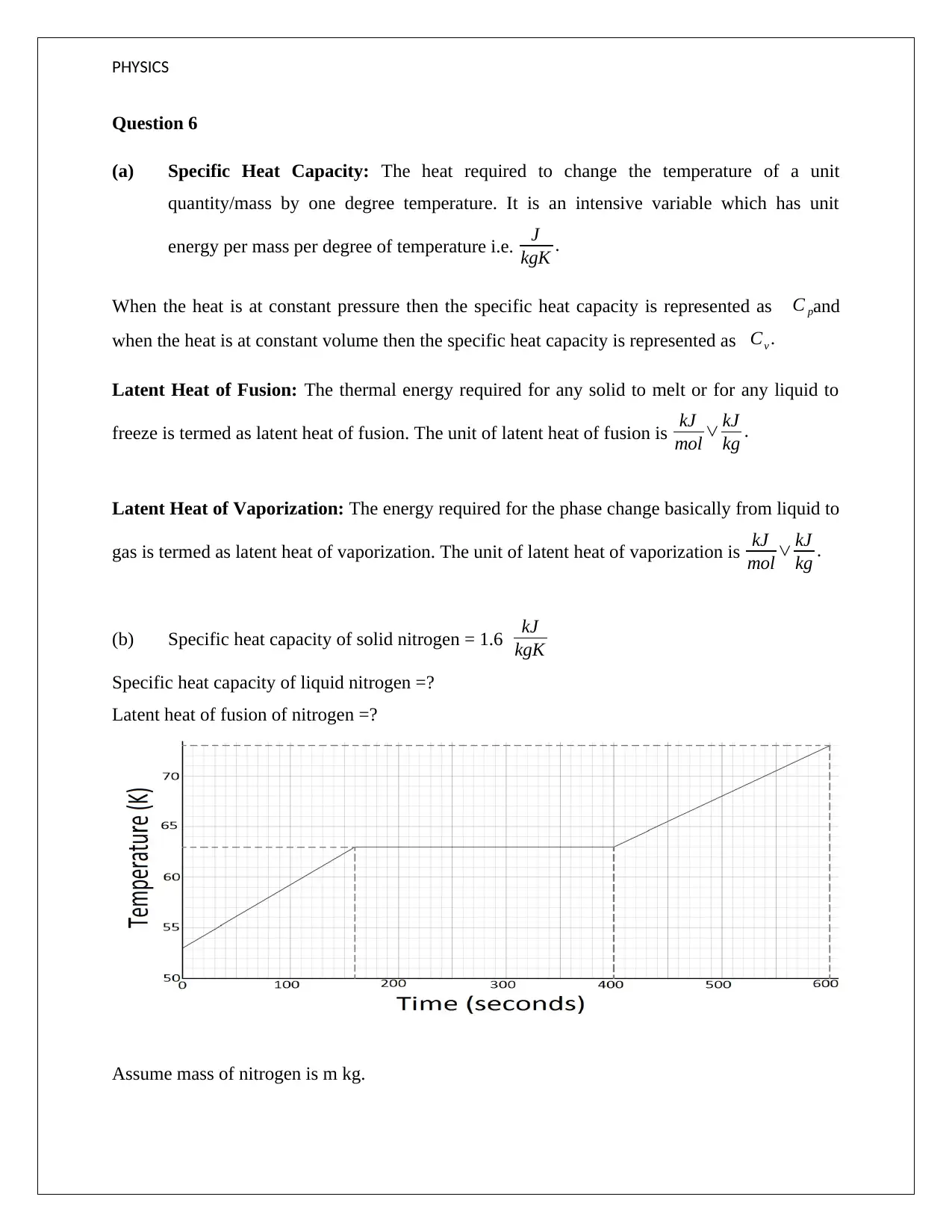
PHYSICS
Question 6
(a) Specific Heat Capacity: The heat required to change the temperature of a unit
quantity/mass by one degree temperature. It is an intensive variable which has unit
energy per mass per degree of temperature i.e. J
kgK .
When the heat is at constant pressure then the specific heat capacity is represented as C pand
when the heat is at constant volume then the specific heat capacity is represented as Cv .
Latent Heat of Fusion: The thermal energy required for any solid to melt or for any liquid to
freeze is termed as latent heat of fusion. The unit of latent heat of fusion is kJ
mol ∨ kJ
kg .
Latent Heat of Vaporization: The energy required for the phase change basically from liquid to
gas is termed as latent heat of vaporization. The unit of latent heat of vaporization is kJ
mol ∨ kJ
kg .
(b) Specific heat capacity of solid nitrogen = 1.6 kJ
kgK
Specific heat capacity of liquid nitrogen =?
Latent heat of fusion of nitrogen =?
Assume mass of nitrogen is m kg.
Question 6
(a) Specific Heat Capacity: The heat required to change the temperature of a unit
quantity/mass by one degree temperature. It is an intensive variable which has unit
energy per mass per degree of temperature i.e. J
kgK .
When the heat is at constant pressure then the specific heat capacity is represented as C pand
when the heat is at constant volume then the specific heat capacity is represented as Cv .
Latent Heat of Fusion: The thermal energy required for any solid to melt or for any liquid to
freeze is termed as latent heat of fusion. The unit of latent heat of fusion is kJ
mol ∨ kJ
kg .
Latent Heat of Vaporization: The energy required for the phase change basically from liquid to
gas is termed as latent heat of vaporization. The unit of latent heat of vaporization is kJ
mol ∨ kJ
kg .
(b) Specific heat capacity of solid nitrogen = 1.6 kJ
kgK
Specific heat capacity of liquid nitrogen =?
Latent heat of fusion of nitrogen =?
Assume mass of nitrogen is m kg.
Paraphrase This Document
Need a fresh take? Get an instant paraphrase of this document with our AI Paraphraser
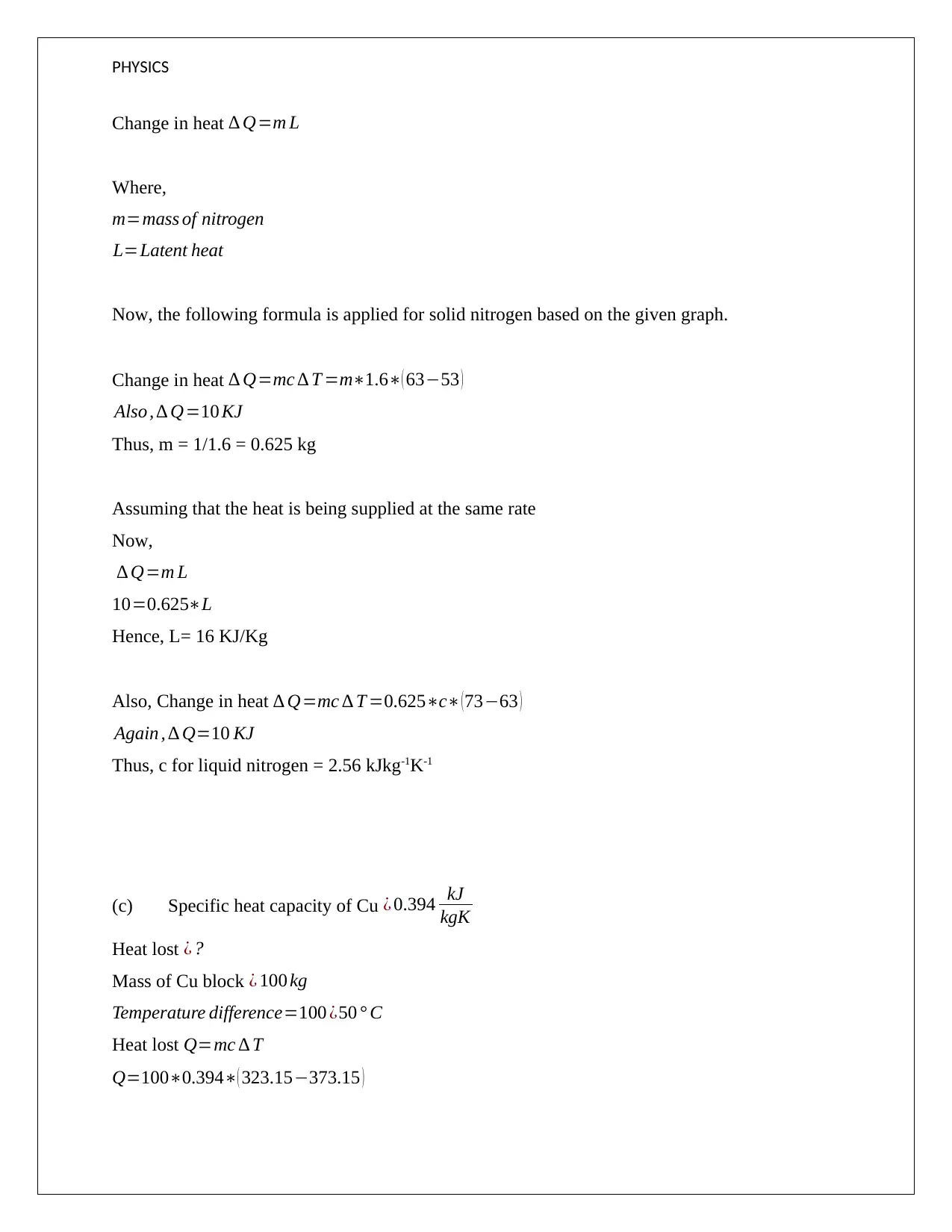
PHYSICS
Change in heat ∆ Q=m L
Where,
m=mass of nitrogen
L=Latent heat
Now, the following formula is applied for solid nitrogen based on the given graph.
Change in heat ∆ Q=mc ∆ T =m∗1.6∗( 63−53 )
Also , ∆ Q=10 KJ
Thus, m = 1/1.6 = 0.625 kg
Assuming that the heat is being supplied at the same rate
Now,
∆ Q=m L
10=0.625∗L
Hence, L= 16 KJ/Kg
Also, Change in heat ∆ Q=mc ∆ T =0.625∗c∗ (73−63 )
Again , ∆ Q=10 KJ
Thus, c for liquid nitrogen = 2.56 kJkg-1K-1
(c) Specific heat capacity of Cu ¿ 0.394 kJ
kgK
Heat lost ¿ ?
Mass of Cu block ¿ 100 kg
Temperature difference=100 ¿50 ° C
Heat lost Q=mc ∆ T
Q=100∗0.394∗( 323.15−373.15 )
Change in heat ∆ Q=m L
Where,
m=mass of nitrogen
L=Latent heat
Now, the following formula is applied for solid nitrogen based on the given graph.
Change in heat ∆ Q=mc ∆ T =m∗1.6∗( 63−53 )
Also , ∆ Q=10 KJ
Thus, m = 1/1.6 = 0.625 kg
Assuming that the heat is being supplied at the same rate
Now,
∆ Q=m L
10=0.625∗L
Hence, L= 16 KJ/Kg
Also, Change in heat ∆ Q=mc ∆ T =0.625∗c∗ (73−63 )
Again , ∆ Q=10 KJ
Thus, c for liquid nitrogen = 2.56 kJkg-1K-1
(c) Specific heat capacity of Cu ¿ 0.394 kJ
kgK
Heat lost ¿ ?
Mass of Cu block ¿ 100 kg
Temperature difference=100 ¿50 ° C
Heat lost Q=mc ∆ T
Q=100∗0.394∗( 323.15−373.15 )
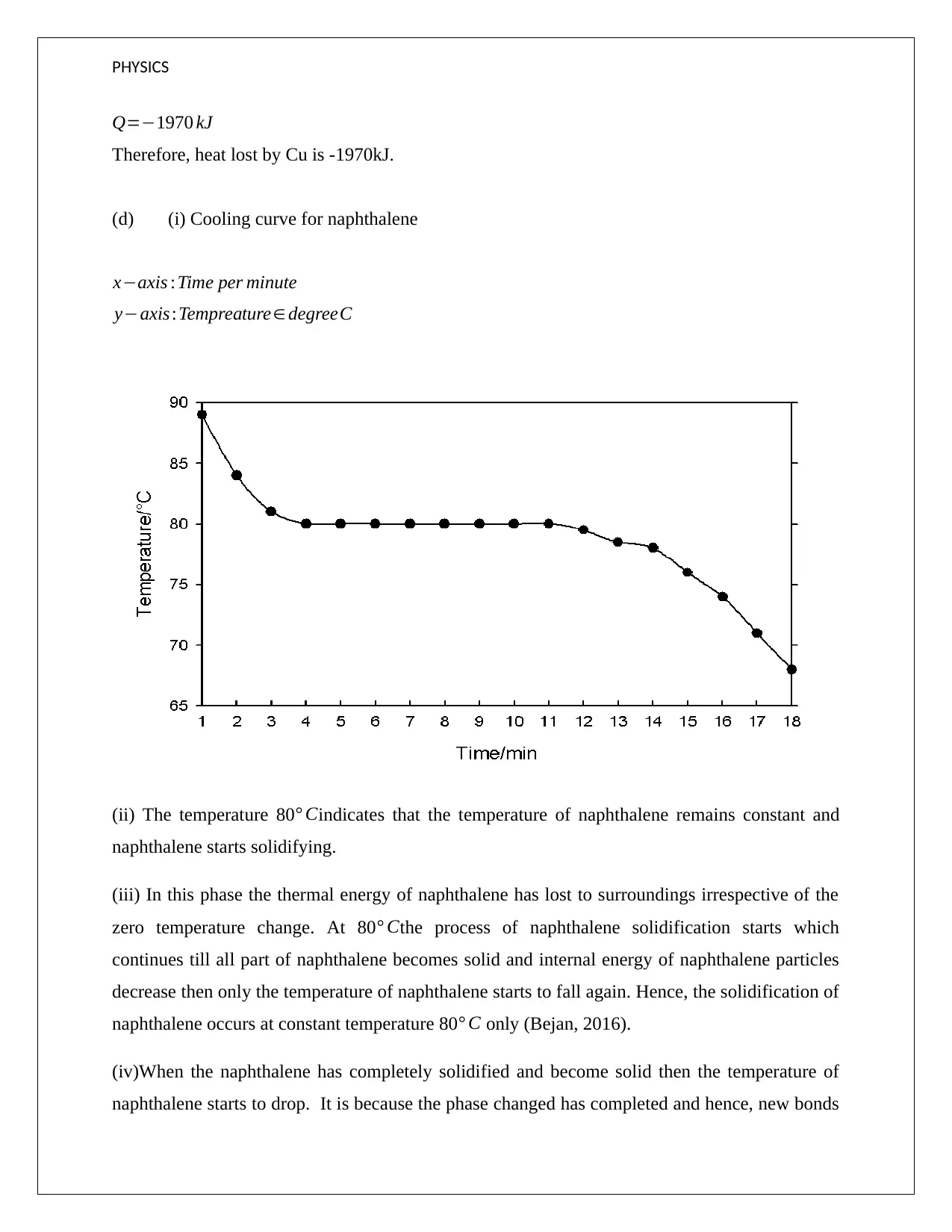
PHYSICS
Q=−1970 kJ
Therefore, heat lost by Cu is -1970kJ.
(d) (i) Cooling curve for naphthalene
x−axis :Time per minute
y−axis:Tempreature∈ degreeC
(ii) The temperature 80° Cindicates that the temperature of naphthalene remains constant and
naphthalene starts solidifying.
(iii) In this phase the thermal energy of naphthalene has lost to surroundings irrespective of the
zero temperature change. At 80° Cthe process of naphthalene solidification starts which
continues till all part of naphthalene becomes solid and internal energy of naphthalene particles
decrease then only the temperature of naphthalene starts to fall again. Hence, the solidification of
naphthalene occurs at constant temperature 80° C only (Bejan, 2016).
(iv)When the naphthalene has completely solidified and become solid then the temperature of
naphthalene starts to drop. It is because the phase changed has completed and hence, new bonds
Q=−1970 kJ
Therefore, heat lost by Cu is -1970kJ.
(d) (i) Cooling curve for naphthalene
x−axis :Time per minute
y−axis:Tempreature∈ degreeC
(ii) The temperature 80° Cindicates that the temperature of naphthalene remains constant and
naphthalene starts solidifying.
(iii) In this phase the thermal energy of naphthalene has lost to surroundings irrespective of the
zero temperature change. At 80° Cthe process of naphthalene solidification starts which
continues till all part of naphthalene becomes solid and internal energy of naphthalene particles
decrease then only the temperature of naphthalene starts to fall again. Hence, the solidification of
naphthalene occurs at constant temperature 80° C only (Bejan, 2016).
(iv)When the naphthalene has completely solidified and become solid then the temperature of
naphthalene starts to drop. It is because the phase changed has completed and hence, new bonds
⊘ This is a preview!⊘
Do you want full access?
Subscribe today to unlock all pages.

Trusted by 1+ million students worldwide
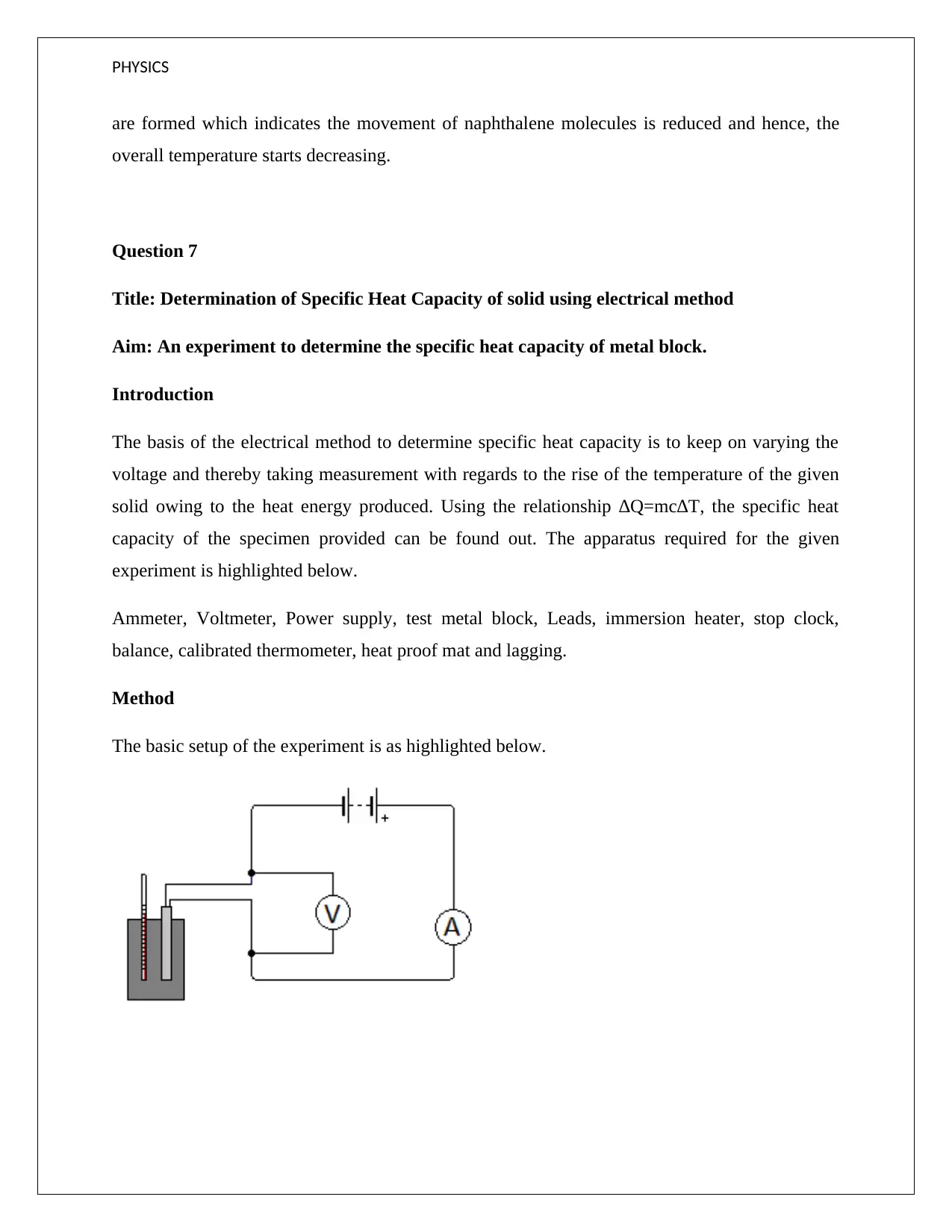
PHYSICS
are formed which indicates the movement of naphthalene molecules is reduced and hence, the
overall temperature starts decreasing.
Question 7
Title: Determination of Specific Heat Capacity of solid using electrical method
Aim: An experiment to determine the specific heat capacity of metal block.
Introduction
The basis of the electrical method to determine specific heat capacity is to keep on varying the
voltage and thereby taking measurement with regards to the rise of the temperature of the given
solid owing to the heat energy produced. Using the relationship ∆Q=mc∆T, the specific heat
capacity of the specimen provided can be found out. The apparatus required for the given
experiment is highlighted below.
Ammeter, Voltmeter, Power supply, test metal block, Leads, immersion heater, stop clock,
balance, calibrated thermometer, heat proof mat and lagging.
Method
The basic setup of the experiment is as highlighted below.
are formed which indicates the movement of naphthalene molecules is reduced and hence, the
overall temperature starts decreasing.
Question 7
Title: Determination of Specific Heat Capacity of solid using electrical method
Aim: An experiment to determine the specific heat capacity of metal block.
Introduction
The basis of the electrical method to determine specific heat capacity is to keep on varying the
voltage and thereby taking measurement with regards to the rise of the temperature of the given
solid owing to the heat energy produced. Using the relationship ∆Q=mc∆T, the specific heat
capacity of the specimen provided can be found out. The apparatus required for the given
experiment is highlighted below.
Ammeter, Voltmeter, Power supply, test metal block, Leads, immersion heater, stop clock,
balance, calibrated thermometer, heat proof mat and lagging.
Method
The basic setup of the experiment is as highlighted below.
Paraphrase This Document
Need a fresh take? Get an instant paraphrase of this document with our AI Paraphraser
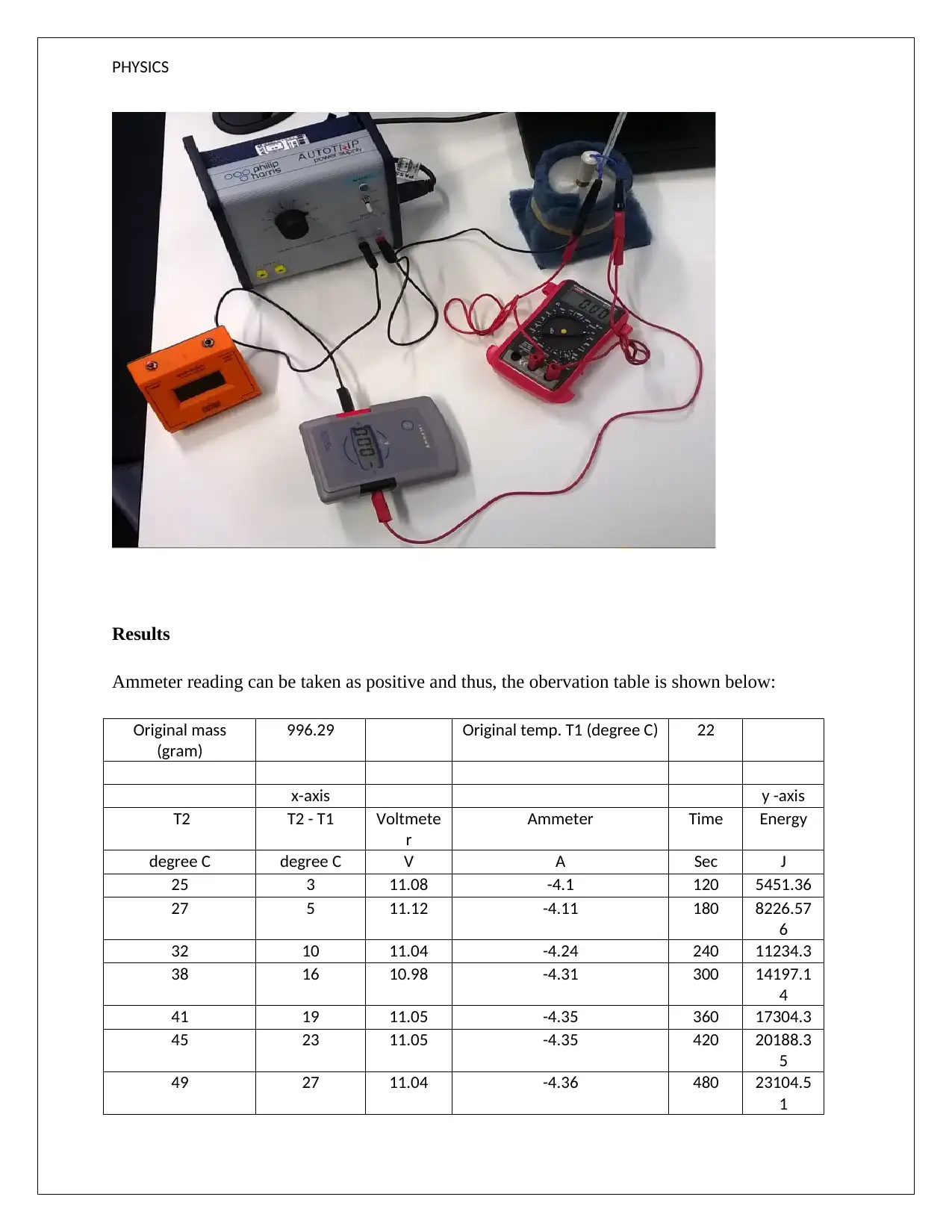
PHYSICS
Results
Ammeter reading can be taken as positive and thus, the obervation table is shown below:
Original mass
(gram)
996.29 Original temp. T1 (degree C) 22
x-axis y -axis
T2 T2 - T1 Voltmete
r
Ammeter Time Energy
degree C degree C V A Sec J
25 3 11.08 -4.1 120 5451.36
27 5 11.12 -4.11 180 8226.57
6
32 10 11.04 -4.24 240 11234.3
38 16 10.98 -4.31 300 14197.1
4
41 19 11.05 -4.35 360 17304.3
45 23 11.05 -4.35 420 20188.3
5
49 27 11.04 -4.36 480 23104.5
1
Results
Ammeter reading can be taken as positive and thus, the obervation table is shown below:
Original mass
(gram)
996.29 Original temp. T1 (degree C) 22
x-axis y -axis
T2 T2 - T1 Voltmete
r
Ammeter Time Energy
degree C degree C V A Sec J
25 3 11.08 -4.1 120 5451.36
27 5 11.12 -4.11 180 8226.57
6
32 10 11.04 -4.24 240 11234.3
38 16 10.98 -4.31 300 14197.1
4
41 19 11.05 -4.35 360 17304.3
45 23 11.05 -4.35 420 20188.3
5
49 27 11.04 -4.36 480 23104.5
1
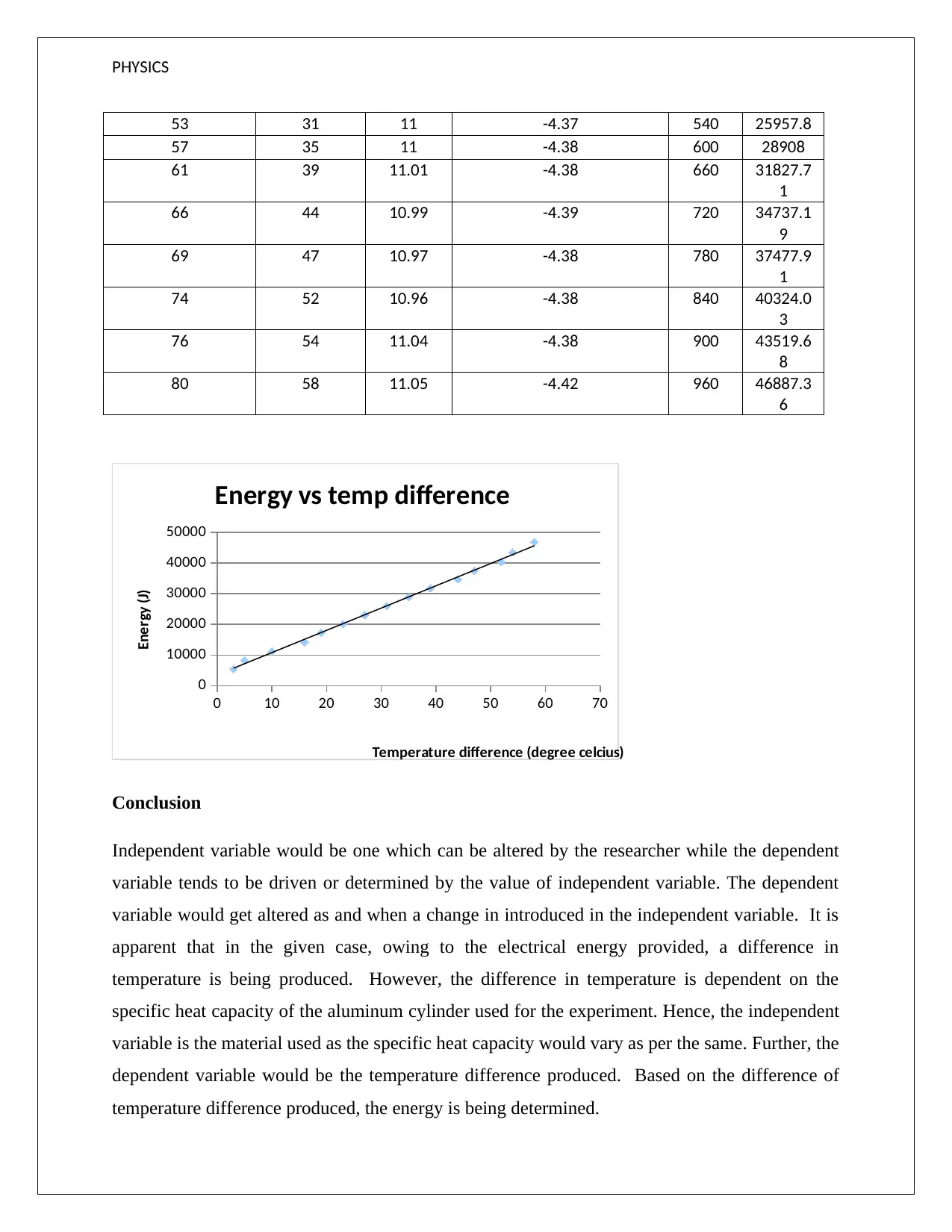
PHYSICS
53 31 11 -4.37 540 25957.8
57 35 11 -4.38 600 28908
61 39 11.01 -4.38 660 31827.7
1
66 44 10.99 -4.39 720 34737.1
9
69 47 10.97 -4.38 780 37477.9
1
74 52 10.96 -4.38 840 40324.0
3
76 54 11.04 -4.38 900 43519.6
8
80 58 11.05 -4.42 960 46887.3
6
0 10 20 30 40 50 60 70
0
10000
20000
30000
40000
50000
Energy vs temp difference
Temperature difference (degree celcius)
Energy (J)
Conclusion
Independent variable would be one which can be altered by the researcher while the dependent
variable tends to be driven or determined by the value of independent variable. The dependent
variable would get altered as and when a change in introduced in the independent variable. It is
apparent that in the given case, owing to the electrical energy provided, a difference in
temperature is being produced. However, the difference in temperature is dependent on the
specific heat capacity of the aluminum cylinder used for the experiment. Hence, the independent
variable is the material used as the specific heat capacity would vary as per the same. Further, the
dependent variable would be the temperature difference produced. Based on the difference of
temperature difference produced, the energy is being determined.
53 31 11 -4.37 540 25957.8
57 35 11 -4.38 600 28908
61 39 11.01 -4.38 660 31827.7
1
66 44 10.99 -4.39 720 34737.1
9
69 47 10.97 -4.38 780 37477.9
1
74 52 10.96 -4.38 840 40324.0
3
76 54 11.04 -4.38 900 43519.6
8
80 58 11.05 -4.42 960 46887.3
6
0 10 20 30 40 50 60 70
0
10000
20000
30000
40000
50000
Energy vs temp difference
Temperature difference (degree celcius)
Energy (J)
Conclusion
Independent variable would be one which can be altered by the researcher while the dependent
variable tends to be driven or determined by the value of independent variable. The dependent
variable would get altered as and when a change in introduced in the independent variable. It is
apparent that in the given case, owing to the electrical energy provided, a difference in
temperature is being produced. However, the difference in temperature is dependent on the
specific heat capacity of the aluminum cylinder used for the experiment. Hence, the independent
variable is the material used as the specific heat capacity would vary as per the same. Further, the
dependent variable would be the temperature difference produced. Based on the difference of
temperature difference produced, the energy is being determined.
⊘ This is a preview!⊘
Do you want full access?
Subscribe today to unlock all pages.

Trusted by 1+ million students worldwide
1 out of 21
Your All-in-One AI-Powered Toolkit for Academic Success.
+13062052269
info@desklib.com
Available 24*7 on WhatsApp / Email
![[object Object]](/_next/static/media/star-bottom.7253800d.svg)
Unlock your academic potential
Copyright © 2020–2025 A2Z Services. All Rights Reserved. Developed and managed by ZUCOL.

